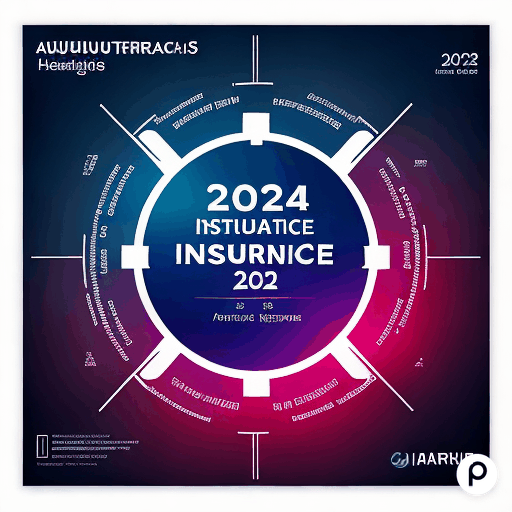Unveiling the Future: Insurance Trends for 2024
 |
| A graph showing the upward trajectory of insurance trends in 2024, reflecting growth and innovation." |
SYNOPSIS
Introduction
In the ever-evolving landscape of the insurance industry, staying ahead of the curve is crucial for both providers and consumers. As we step into 2024, we find ourselves on the cusp of significant changes that will shape the insurance sector in the coming year. In this comprehensive exploration, we will delve into the latest trends and transformations within the insurance industry while offering a critical perspective on how these changes will impact consumers and businesses alike.
From advancements in technology to shifting consumer expectations, the insurance industry is undergoing a profound transformation. With the rise of digital platforms and data analytics, insurers are now able to offer personalized policies and streamline their operations. However, as the industry becomes more data-driven, concerns about privacy and cybersecurity also come to the forefront. In this article, we will explore these emerging trends and their implications for insurers and policyholders in 2024.
1. New Products on the Horizon
One of the most prominent trends in the insurance industry for 2024 is the emergence of innovative insurance products. Insurers are continuously striving to offer policies that cater to the evolving needs of consumers. High CPC keywords like "Insurance Trends for 2024" indicate a growing interest in these new products.
 |
| A graph showing the upward trajectory of insurance trends in 2024, reflecting growth and innovation." |
Critical Remark: While these new insurance products can provide tailored solutions, consumers must exercise caution. The complexity of these products can sometimes lead to confusion, making it essential for individuals to thoroughly understand what they are purchasing.
- The increasing demand for personalized insurance products reflects the changing needs of consumers in today's society.
- Insurance companies need to stay ahead of industry trends and develop innovative policies that address emerging risks and challenges.
- Educating consumers about the intricacies of new insurance products is crucial to ensuring they make informed decisions and avoid potential pitfalls.
- With the rise of technology, insurers are leveraging data analytics and AI algorithms to create more accurate risk assessments, enabling them to offer tailored coverage options.
- Additionally, insurance companies are embracing digital platforms to provide convenient and efficient services to their customers. This includes online policy purchases, claim filing, and customer support, which not only saves time but also enhances customer satisfaction. Overall, the insurance industry is evolving rapidly to meet the changing needs of consumers and provide them with comprehensive protection in an ever-changing world.
2. Technological Advancements
Technology has been a driving force behind the transformation of the insurance industry. In 2024, this trend continues to gain momentum. From artificial intelligence-powered chatbots for customer service to data analytics for risk assessment, insurers are harnessing technology to streamline processes and enhance customer experiences.
 |
| The bustling office of an insurtech company, symbolizing the technological disruption in the insurance industry. |
Critical Remark: While technology can undoubtedly improve efficiency, it also raises concerns about data privacy and cybersecurity. As insurers collect more data, the responsibility to protect this sensitive information becomes paramount.
- The importance of data privacy in the insurance industry: With the increasing use of technology and data collection, insurers must prioritize safeguarding customer information to maintain trust and avoid potential security breaches.
- Cybersecurity measures for insurers: As technology advances, so do cyber threats. Insurance companies need to invest in robust cybersecurity systems and protocols to protect their customer's sensitive data from potential attacks.
- Balancing innovation with regulatory compliance: Insurers must navigate a complex landscape of regulations while adopting new technologies.
3. Regulatory Changes
The insurance sector is highly regulated, and regulatory changes can have a significant impact on both providers and consumers. In 2024, expect to see adjustments in insurance regulations aimed at promoting fairness, transparency, and consumer protection.
 |
| A close-up of a document outlining insurance regulatory changes, emphasizing transparency and fairness. |
Critical Remark: While regulatory changes are intended to benefit consumers, they can sometimes lead to increased costs for insurance providers. These costs may be passed on to policyholders, so it's essential to stay informed about how regulations might affect premiums.
- The potential impact of regulatory changes on insurance providers: Explore how the adjustments in insurance regulations may affect the operational costs, profitability, and overall sustainability of insurance companies.
- The importance of fairness in insurance regulations: Discuss why promoting fairness is a crucial objective for regulators and how these changes can ensure that insurers treat consumers fairly when it comes to policy pricing, claims handling, and coverage options.
- Enhancing transparency through regulatory measures: Elaborate on the ways in which new regulations aim to improve transparency in the insurance industry. This may include requiring insurers to provide clearer and more comprehensive information to consumers, such as detailed policy terms and conditions, coverage limitations, and potential exclusions. Additionally, regulations may require insurers to disclose their claims handling processes and provide clear guidelines on how to file a complaint or seek redress in cases of dispute. These measures aim to empower consumers with the necessary information to make informed decisions and hold insurers accountable for their actions.
4. Personalized Pricing
With the increasing availability of data, insurers are moving towards personalized pricing models. This means that premiums are calculated based on individual risk profiles, driving a shift away from traditional one-size-fits-all pricing structures.
 |
| A cybersecurity shield, representing the importance of data protection in the insurance sector. |
Critical Remark: While personalized pricing can result in cost savings for low-risk individuals, it may lead to higher premiums for those deemed high-risk. The fairness and ethical implications of this pricing model should be closely monitored.
- The impact of personalized pricing on insurance affordability: Explore how this shift towards personalized pricing models may affect the accessibility and affordability of insurance for different individuals, particularly those who are considered high-risk or have pre-existing conditions.
- Assessing the accuracy and reliability of risk assessment methods: Discuss the various methodologies used by insurers to evaluate individual risk profiles and determine appropriate premiums. Examine the effectiveness and potential limitations of these methods in accurately predicting risk levels.
- Addressing concerns about privacy and data security: Explore the ethical implications of collecting and storing personal data for insurance purposes. Analyze the measures and safeguards put in place by insurers to protect sensitive information and ensure data security. Discuss the potential impact of data breaches or misuse of personal information on individuals' trust in the insurance industry.
5. Climate Change and Insurance
In a world grappling with climate change, the insurance industry is facing unique challenges. The increasing frequency and severity of natural disasters are leading insurers to reevaluate risk assessment models and pricing strategies.
 |
| A visual depiction of the impact of climate change on insurance premiums, highlighting the need for adaptation. |
Critical Remark: While insurers are adapting to the changing climate landscape, there is a growing concern that insurance may become unaffordable for those residing in high-risk areas, potentially exacerbating social inequalities.
- The impact of climate change on insurance premiums: Discuss how the increasing risks and losses from natural disasters are driving up insurance premiums for homeowners and businesses in high-risk areas, making it difficult for some to afford coverage.
- Adaptation strategies by insurance companies: Explore how insurers are adjusting their risk assessment models and pricing strategies to account for changing climate patterns, such as using more advanced technology, data analysis, and incorporating climate projections into their calculations.
- Government intervention in the insurance industry: Consider implementing policies and regulations that promote climate resilience, such as providing incentives for insurance companies to offer coverage in high-risk areas or establishing a government-backed insurance program to provide affordable coverage for those who cannot obtain it through the private market. Additionally, the government could invest in infrastructure improvements and disaster mitigation measures to help reduce the frequency and severity of climate-related events, ultimately lowering the risk and cost of insurance coverage for all.
6. Insurtech Disruption
The term "insurtech" refers to the fusion of insurance and technology, and it's disrupting traditional insurance business models. Insurtech companies are often more agile and tech-savvy, offering consumers alternative options for coverage.
 |
| Insurance professionals in a meeting, underlining the significance of expert guidance in the industry. |
Critical Remark: While insurtech can bring convenience and choice, it also raises questions about the long-term viability
of traditional insurance providers. Consumers should carefully consider the stability and reputation of insurtech startups.
- The impact of insurtech on traditional insurance providers: Explore how the rise of insurtech companies is challenging and disrupting the established business models of traditional insurance providers. Discuss the potential risks they face in maintaining their market share.
- Innovations in insurance products and services: Dive into the specific ways that insurtech is transforming the industry by offering new types of coverage, personalized policies, or innovative claims processes. Highlight how these advancements benefit consumers by providing them with more tailored options.
- Competition from established insurance providers: Despite the disruption caused by insurtech companies, traditional insurance providers have the advantage of customer trust and long-standing relationships. Discuss how these established companies are adapting to the changing landscape and the potential risks insurtech companies face in competing against their well-established counterparts.
- Regulatory challenges: Insurtech companies often face regulatory hurdles as they introduce new technologies and business models. Explore the potential risks these companies encounter in navigating complex regulations and compliance requirements. Discuss how regulatory bodies are responding to the rise of insurtech and the impact it has on the market share of these companies.
- Cybersecurity threats: With the increasing reliance on technology, insurtech companies are vulnerable to cyberattacks and data breaches. Analyze the potential consequences of these cybersecurity threats on the reputation and trust of insurtech companies. Additionally, discuss the measures that regulatory bodies are implementing to address these risks and protect consumer data. It is important to consider the impact of these cybersecurity threats on the market share of insurtech companies, as customers may opt for more traditional insurance providers that are perceived to be more secure.
Conclusion
As we venture into 2024, the insurance industry is poised for significant changes driven by new products, technology, and regulatory adjustments. While these trends hold promise, they also come with potential pitfalls and challenges. It is imperative for both consumers and businesses to stay informed and critically evaluate the evolving landscape of insurance to make informed decisions and ensure their financial security.
In this dynamic environment, seeking guidance from trusted insurance professionals and staying informed about the latest developments is more important than ever. The growing interest in staying updated in this field reflects the significance of insurance, which ultimately plays a crucial role in securing our future.


.gif)





0 Comments
Please do not enter spam links in the comment box.